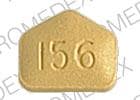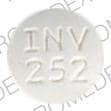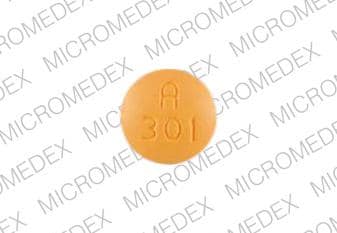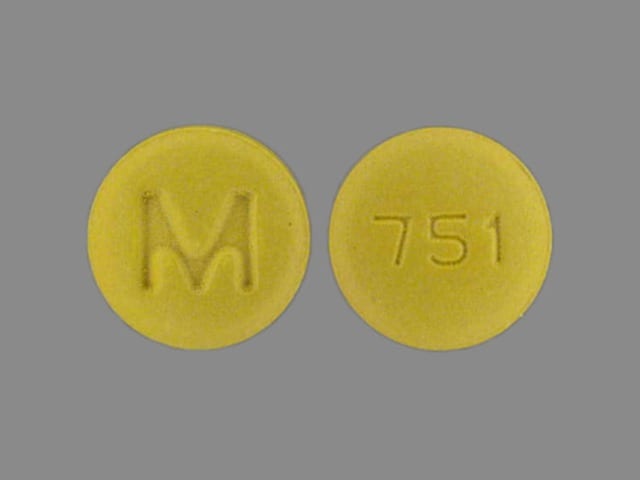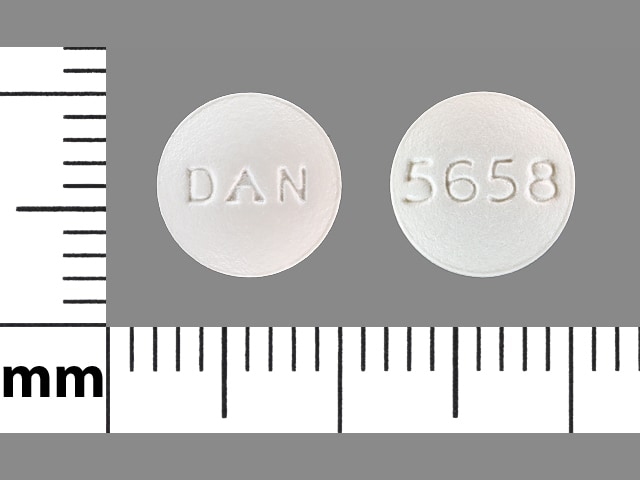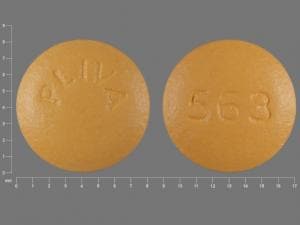Dosage Forms
Excipient information presented when available (limited, particularly for generics); consult specific product labeling.
Capsule Extended Release 24 Hour, Oral, as hydrochloride:
Amrix: 15 mg [contains fd&c red #40, fd&c yellow #10 (quinoline yellow)]
Amrix: 30 mg [contains brilliant blue fcf (fd&c blue #1), fd&c blue #2 (indigotine), fd&c red #40, fd&c yellow #6 (sunset yellow)]
Generic: 15 mg, 30 mg
Tablet, Oral, as hydrochloride:
Fexmid: 7.5 mg
Generic: 5 mg, 7.5 mg, 10 mg
Pharmacology
Mechanism of Action
Centrally-acting skeletal muscle relaxant pharmacologically related to tricyclic antidepressants; reduces tonic somatic motor activity influencing both alpha and gamma motor neurons
Pharmacokinetics/Pharmacodynamics
Metabolism
Hepatic via CYP3A4, 1A2, and 2D6; may undergo enterohepatic recirculation
Excretion
Urine (primarily as glucuronide metabolites); feces (as unchanged drug; Hucker, 1978); Clearance: 0.7 L/minute
Onset of Action
Immediate release: Within 1 hour
Time to Peak
Immediate release: ~4 hours (Winchell 2002); Extended release: 7 to 8 hours
Duration of Action
Immediate release: 12 to 24 hours
Half-Life Elimination
Normal hepatic function: Range: 8 to 37 hours; Immediate release: 18 hours; Extended release: 32 hours; Impaired hepatic function: 46.2 hours (range: 22.4 to 188 hours) (Winchell 2002)
Use in Specific Populations
Special Populations: Hepatic Function Impairment
In mild-to-moderate hepatic impairment, AUC and Cmax increased approximately twofold with immediate-release cyclobenzaprine.
Special Populations: Elderly
AUC increased ~2.4-fold in elderly males and ~1.2-fold in elderly females with immediate-release cyclobenzaprine. AUC increased 40% and the plasma half-life is prolonged (50 hours) in elderly subjects with extended-release cyclobenzaprine.
Use: Labeled Indications
Muscle spasm: As an adjunct to rest and physical therapy for short-term (2 to 3 weeks) relief of muscle spasm associated with acute, painful musculoskeletal conditions.
Use: Off Label
Fibromyalgiabyes
Data from multiple double-blind, placebo-controlled trials Bennett 1988, Quimby 1989 support the use of cyclobenzaprine in the treatment of fibromyalgia.
Based on the European League Against Rheumatism revised recommendations for the management of fibromyalgia, cyclobenzaprine is recommended as an alternative agent in the management of this condition EULAR [Macfarlane 2017].
Temporomandibular disorder, acutec
Data from 2 randomized, double-blind, placebo-controlled trials of patients experiencing myofascial jaw pain upon awakening suggest that cyclobenzaprine at bedtime may have some benefit for the treatment of acute jaw pain due to temporomandibular disorder Alencar 2014, Herman 2002. Of note, 1 study demonstrated significant improvement in pain scores with treatment; however, no significant differences were seen compared to placebo Alencar 2014.
Contraindications
Hypersensitivity to cyclobenzaprine or any component of the formulation; during or within 14 days of MAO inhibitors; hyperthyroidism; heart failure; arrhythmias; heart block or conduction disturbances; acute recovery phase of MI
Dosage and Administration
Dosing: Adult
Note: Patients more sensitive to sedating and other CNS adverse effects (eg, those who are older, debilitated patients, those with organ impairment) may better tolerate a reduced dose, less frequent administration, and/or more gradual titration (Chou 2019).
Fibromyalgia (alternative agent) (off-label use):
Note: For mild to moderate symptoms, particularly with sleep disturbance (EULAR [Macfarlane 2017]; Goldenberg 2019; Tofferi 2004).
Oral: Immediate release: Initial: 5 to 10 mg once daily before bedtime; may gradually titrate as needed and tolerated up to 10 to 40 mg daily in 1 to 3 divided doses (Calandre 2015; EULAR [Macfarlane 2017]; Goldenberg 2019; Tofferi 2004). If excessive sedation occurs, may divide dose so larger portion is taken at bedtime (eg, 5 mg in morning and 10 or 15 mg at bedtime) (Goldenberg 2019; Tofferi 2004).
Muscle spasm and/or musculoskeletal pain (adjunctive therapy):
Note: For skeletal muscle spasm and/or pain (eg, low back pain, neck pain) with muscle spasm, usually in combination with a nonsteroidal anti-inflammatory drug (NSAID) and/or acetaminophen (ACP [Chou 2017]; Borenstein 2003; van Tulder 2003). In general, muscle relaxants should be used temporarily (eg, for a few days or intermittently for a few days when needed) (APS 2016).
Oral: Immediate release: Initial: 5 mg 3 times daily scheduled or as needed with one of the doses administered at bedtime (Chou 2019). May increase dose based on response and tolerability up to 10 mg 3 times daily as needed. Once-daily use at bedtime (with daytime NSAID and/or acetaminophen) may be better tolerated (Knight 2019).
Oral: Extended release: Usual: 15 mg once daily; some patients may require up to 30 mg once daily.
Temporomandibular disorder, acute (adjunctive therapy) (off-label use):
Note: Adjunct to an NSAID in select patients with pain on palpation of the lower jaw muscle (Alencar 2014; Herman 2002; Mehta 2019).
Oral: Immediate release: Usual: 10 mg once daily at bedtime for 10 to 14 days (Alencar 2014; Herman 2002; Mehta 2019).
Dosing: Geriatric
Avoid use (Beers Criteria [AGS 2019]).
Dosing: Pediatric
Muscle spasm, treatment: Adolescents ≥15 years: Oral: Immediate release tablet: Initial: 5 mg 3 times daily; may increase up to 10 mg 3 times daily if needed. Do not use longer than 2 to 3 weeks.
Administration
Oral: Extended release: Swallow whole and administer at the same time each day. Alternatively, the contents of the capsule may be sprinkled onto a tablespoon of applesauce and consume immediately without chewing; rinse mouth to ensure all contents have been swallowed; discard any unused portion of capsule.
Storage
Capsules: Store at 25°C (77°F); excursions are permitted to 15°C to 30°C (59°F to 86°F).
Tablets: Store between 20°C and 25°C (68°F and 77°F).
Cyclobenzaprine Images
Drug Interactions
Acetylcholinesterase Inhibitors: May diminish the therapeutic effect of Anticholinergic Agents. Anticholinergic Agents may diminish the therapeutic effect of Acetylcholinesterase Inhibitors. Monitor therapy
Aclidinium: May enhance the anticholinergic effect of Anticholinergic Agents. Avoid combination
Alcohol (Ethyl): CNS Depressants may enhance the CNS depressant effect of Alcohol (Ethyl). Monitor therapy
Alizapride: May enhance the CNS depressant effect of CNS Depressants. Monitor therapy
Amantadine: May enhance the anticholinergic effect of Anticholinergic Agents. Monitor therapy
Anticholinergic Agents: May enhance the adverse/toxic effect of other Anticholinergic Agents. Monitor therapy
Azelastine (Nasal): CNS Depressants may enhance the CNS depressant effect of Azelastine (Nasal). Avoid combination
Blonanserin: CNS Depressants may enhance the CNS depressant effect of Blonanserin. Consider therapy modification
Botulinum Toxin-Containing Products: May enhance the anticholinergic effect of Anticholinergic Agents. Monitor therapy
Botulinum Toxin-Containing Products: Muscle Relaxants (Centrally Acting) may enhance the adverse/toxic effect of Botulinum Toxin-Containing Products. Specifically, the risk for increased muscle weakness may be enhanced. Monitor therapy
Brexanolone: CNS Depressants may enhance the CNS depressant effect of Brexanolone. Monitor therapy
Brimonidine (Topical): May enhance the CNS depressant effect of CNS Depressants. Monitor therapy
Bromopride: May enhance the CNS depressant effect of CNS Depressants. Monitor therapy
Bromperidol: May enhance the CNS depressant effect of CNS Depressants. Avoid combination
Buprenorphine: CNS Depressants may enhance the CNS depressant effect of Buprenorphine. Management: Consider reduced doses of other CNS depressants, and avoiding such drugs in patients at high risk of buprenorphine overuse/self-injection. Initiate buprenorphine at lower doses in patients already receiving CNS depressants. Consider therapy modification
Cannabidiol: May enhance the CNS depressant effect of CNS Depressants. Monitor therapy
Cannabis: May enhance the CNS depressant effect of CNS Depressants. Monitor therapy
Chloral Betaine: May enhance the adverse/toxic effect of Anticholinergic Agents. Monitor therapy
Chlormethiazole: May enhance the CNS depressant effect of CNS Depressants. Management: Monitor closely for evidence of excessive CNS depression. The chlormethiazole labeling states that an appropriately reduced dose should be used if such a combination must be used. Consider therapy modification
Chlorphenesin Carbamate: May enhance the adverse/toxic effect of CNS Depressants. Monitor therapy
Cimetropium: Anticholinergic Agents may enhance the anticholinergic effect of Cimetropium. Avoid combination
CNS Depressants: May enhance the adverse/toxic effect of other CNS Depressants. Monitor therapy
Dimethindene (Topical): May enhance the CNS depressant effect of CNS Depressants. Monitor therapy
Doxylamine: May enhance the CNS depressant effect of CNS Depressants. Management: The manufacturer of Diclegis (doxylamine/pyridoxine), intended for use in pregnancy, specifically states that use with other CNS depressants is not recommended. Monitor therapy
Dronabinol: May enhance the CNS depressant effect of CNS Depressants. Monitor therapy
Droperidol: May enhance the CNS depressant effect of CNS Depressants. Management: Consider dose reductions of droperidol or of other CNS agents (eg, opioids, barbiturates) with concomitant use. Exceptions to this monograph are discussed in further detail in separate drug interaction monographs. Consider therapy modification
Eluxadoline: Anticholinergic Agents may enhance the constipating effect of Eluxadoline. Avoid combination
Esketamine: May enhance the CNS depressant effect of CNS Depressants. Monitor therapy
Flunitrazepam: CNS Depressants may enhance the CNS depressant effect of Flunitrazepam. Consider therapy modification
Gastrointestinal Agents (Prokinetic): Anticholinergic Agents may diminish the therapeutic effect of Gastrointestinal Agents (Prokinetic). Monitor therapy
Glucagon: Anticholinergic Agents may enhance the adverse/toxic effect of Glucagon. Specifically, the risk of gastrointestinal adverse effects may be increased. Monitor therapy
Glycopyrrolate (Oral Inhalation): Anticholinergic Agents may enhance the anticholinergic effect of Glycopyrrolate (Oral Inhalation). Avoid combination
Glycopyrronium (Topical): May enhance the anticholinergic effect of Anticholinergic Agents. Avoid combination
HYDROcodone: CNS Depressants may enhance the CNS depressant effect of HYDROcodone. Management: Avoid concomitant use of hydrocodone and benzodiazepines or other CNS depressants when possible. These agents should only be combined if alternative treatment options are inadequate. If combined, limit the dosages and duration of each drug. Consider therapy modification
HydrOXYzine: May enhance the CNS depressant effect of CNS Depressants. Monitor therapy
Ipratropium (Oral Inhalation): May enhance the anticholinergic effect of Anticholinergic Agents. Avoid combination
Itopride: Anticholinergic Agents may diminish the therapeutic effect of Itopride. Monitor therapy
Kava Kava: May enhance the adverse/toxic effect of CNS Depressants. Monitor therapy
Lemborexant: May enhance the CNS depressant effect of CNS Depressants. Management: Dosage adjustments of lemborexant and of concomitant CNS depressants may be necessary when administered together because of potentially additive CNS depressant effects. Close monitoring for CNS depressant effects is necessary. Consider therapy modification
Levosulpiride: Anticholinergic Agents may diminish the therapeutic effect of Levosulpiride. Avoid combination
Lofexidine: May enhance the CNS depressant effect of CNS Depressants. Management: Drugs listed as exceptions to this monograph are discussed in further detail in separate drug interaction monographs. Monitor therapy
Magnesium Sulfate: May enhance the CNS depressant effect of CNS Depressants. Monitor therapy
Methotrimeprazine: CNS Depressants may enhance the CNS depressant effect of Methotrimeprazine. Methotrimeprazine may enhance the CNS depressant effect of CNS Depressants. Management: Reduce adult dose of CNS depressant agents by 50% with initiation of concomitant methotrimeprazine therapy. Further CNS depressant dosage adjustments should be initiated only after clinically effective methotrimeprazine dose is established. Consider therapy modification
MetyroSINE: CNS Depressants may enhance the sedative effect of MetyroSINE. Monitor therapy
Mianserin: May enhance the anticholinergic effect of Anticholinergic Agents. Monitor therapy
Minocycline (Systemic): May enhance the CNS depressant effect of CNS Depressants. Monitor therapy
Mirabegron: Anticholinergic Agents may enhance the adverse/toxic effect of Mirabegron. Monitor therapy
Monoamine Oxidase Inhibitors: Cyclobenzaprine may enhance the serotonergic effect of Monoamine Oxidase Inhibitors. This could result in serotonin syndrome. Avoid combination
Nabilone: May enhance the CNS depressant effect of CNS Depressants. Monitor therapy
Nitroglycerin: Anticholinergic Agents may decrease the absorption of Nitroglycerin. Specifically, anticholinergic agents may decrease the dissolution of sublingual nitroglycerin tablets, possibly impairing or slowing nitroglycerin absorption. Monitor therapy
Ombitasvir, Paritaprevir, and Ritonavir: May decrease the serum concentration of Cyclobenzaprine. Monitor therapy
Ombitasvir, Paritaprevir, Ritonavir, and Dasabuvir: May decrease the serum concentration of Cyclobenzaprine. Monitor therapy
Opioid Agonists: CNS Depressants may enhance the CNS depressant effect of Opioid Agonists. Management: Avoid concomitant use of opioid agonists and benzodiazepines or other CNS depressants when possible. These agents should only be combined if alternative treatment options are inadequate. If combined, limit the dosages and duration of each drug. Consider therapy modification
Orphenadrine: CNS Depressants may enhance the CNS depressant effect of Orphenadrine. Avoid combination
Oxatomide: May enhance the anticholinergic effect of Anticholinergic Agents. Avoid combination
Oxomemazine: May enhance the CNS depressant effect of CNS Depressants. Avoid combination
OxyCODONE: CNS Depressants may enhance the CNS depressant effect of OxyCODONE. Management: Avoid concomitant use of oxycodone and benzodiazepines or other CNS depressants when possible. These agents should only be combined if alternative treatment options are inadequate. If combined, limit the dosages and duration of each drug. Consider therapy modification
Paraldehyde: CNS Depressants may enhance the CNS depressant effect of Paraldehyde. Avoid combination
Perampanel: May enhance the CNS depressant effect of CNS Depressants. Management: Patients taking perampanel with any other drug that has CNS depressant activities should avoid complex and high-risk activities, particularly those such as driving that require alertness and coordination, until they have experience using the combination. Consider therapy modification
Piribedil: CNS Depressants may enhance the CNS depressant effect of Piribedil. Monitor therapy
Potassium Chloride: Anticholinergic Agents may enhance the ulcerogenic effect of Potassium Chloride. Management: Patients on drugs with substantial anticholinergic effects should avoid using any solid oral dosage form of potassium chloride. Avoid combination
Potassium Citrate: Anticholinergic Agents may enhance the ulcerogenic effect of Potassium Citrate. Avoid combination
Pramipexole: CNS Depressants may enhance the sedative effect of Pramipexole. Monitor therapy
Pramlintide: May enhance the anticholinergic effect of Anticholinergic Agents. These effects are specific to the GI tract. Consider therapy modification
Ramosetron: Anticholinergic Agents may enhance the constipating effect of Ramosetron. Monitor therapy
Revefenacin: Anticholinergic Agents may enhance the anticholinergic effect of Revefenacin. Avoid combination
ROPINIRole: CNS Depressants may enhance the sedative effect of ROPINIRole. Monitor therapy
Rotigotine: CNS Depressants may enhance the sedative effect of Rotigotine. Monitor therapy
Rufinamide: May enhance the adverse/toxic effect of CNS Depressants. Specifically, sleepiness and dizziness may be enhanced. Monitor therapy
Secretin: Anticholinergic Agents may diminish the therapeutic effect of Secretin. Management: Avoid concomitant use of anticholinergic agents and secretin. Discontinue anticholinergic agents at least 5 half-lives prior to administration of secretin. Consider therapy modification
Serotonergic Agents (High Risk): Cyclobenzaprine may enhance the serotonergic effect of Serotonergic Agents (High Risk). This could result in serotonin syndrome. Management: Monitor for signs and symptoms of serotonin syndrome/serotonin toxicity (eg, hyperreflexia, clonus, hyperthermia, diaphoresis, tremor, autonomic instability, mental status changes) when these agents are combined. Exceptions: Isocarboxazid; Linezolid; Methylene Blue; Moclobemide; Phenelzine; Tranylcypromine. Monitor therapy
Sodium Oxybate: May enhance the CNS depressant effect of CNS Depressants. Management: Consider alternatives to combined use. When combined use is needed, consider minimizing doses of one or more drugs. Use of sodium oxybate with alcohol or sedative hypnotics is contraindicated. Consider therapy modification
Suvorexant: CNS Depressants may enhance the CNS depressant effect of Suvorexant. Management: Dose reduction of suvorexant and/or any other CNS depressant may be necessary. Use of suvorexant with alcohol is not recommended, and the use of suvorexant with any other drug to treat insomnia is not recommended. Consider therapy modification
Tapentadol: May enhance the CNS depressant effect of CNS Depressants. Management: Avoid concomitant use of tapentadol and benzodiazepines or other CNS depressants when possible. These agents should only be combined if alternative treatment options are inadequate. If combined, limit the dosages and duration of each drug. Consider therapy modification
Tetrahydrocannabinol: May enhance the CNS depressant effect of CNS Depressants. Monitor therapy
Tetrahydrocannabinol and Cannabidiol: May enhance the CNS depressant effect of CNS Depressants. Monitor therapy
Thalidomide: CNS Depressants may enhance the CNS depressant effect of Thalidomide. Avoid combination
Thiazide and Thiazide-Like Diuretics: Anticholinergic Agents may increase the serum concentration of Thiazide and Thiazide-Like Diuretics. Monitor therapy
Tiotropium: Anticholinergic Agents may enhance the anticholinergic effect of Tiotropium. Avoid combination
Tolperisone: May enhance the adverse/toxic effect of Muscle Relaxants (Centrally Acting). Management: Monitor for increased sedation or CNS effects if tolperisone is combined with other centrally acting muscle relaxants. Consider decreasing the tolperisone dose if these agents are combined. Consider therapy modification
Topiramate: Anticholinergic Agents may enhance the adverse/toxic effect of Topiramate. Monitor therapy
Trimeprazine: May enhance the CNS depressant effect of CNS Depressants. Monitor therapy
Umeclidinium: May enhance the anticholinergic effect of Anticholinergic Agents. Avoid combination
Zolpidem: CNS Depressants may enhance the CNS depressant effect of Zolpidem. Management: Reduce the Intermezzo brand sublingual zolpidem adult dose to 1.75 mg for men who are also receiving other CNS depressants. No such dose change is recommended for women. Avoid use with other CNS depressants at bedtime; avoid use with alcohol. Consider therapy modification
Test Interactions
May cause false-positive serum TCA screen (Wong, 1995)
Adverse Reactions
>10%:
Central nervous system: Drowsiness (1% to 39%), dizziness (1% to 11%)
Gastrointestinal: Xerostomia (6% to 32%)
1% to 10%:
Central nervous system: Fatigue (1% to 6%), headache (1% to 5%), confusion (1% to 3%), decreased mental acuity (1% to 3%), irritability (1% to 3%), nervousness (1% to 3%)
Gastrointestinal: Dyspepsia (≤4%), abdominal pain (1% to 3%), acid regurgitation (1% to 3%), constipation (1% to 3%), diarrhea (1% to 3%), nausea (1% to 3%), unpleasant taste (1% to 3%)
Neuromuscular & skeletal: Weakness (1% to 3%)
Ophthalmic: Blurred vision (1% to 3%)
Respiratory: Pharyngitis (1% to 3%), upper respiratory tract infection (1% to 3%)
<1%, postmarketing, and/or case reports: Abnormal dreams, abnormal hepatic function tests, abnormality in thinking, ageusia, agitation, anaphylaxis, angioedema, anorexia, anxiety, ataxia, cardiac arrhythmia, cholestasis, convulsions, depression, diaphoresis, diplopia, disorientation, dysarthria, excitement (paradoxical, children), facial edema, flatulence, gastritis, gastrointestinal pain, hallucination, hepatitis (rare), hypertonia, hypotension, increased thirst, insomnia, jaundice, malaise, muscle twitching, palpitations, paresthesia, pruritus, psychosis, seizure, serotonin syndrome, skin rash, syncope, tachycardia, tinnitus, tongue edema, tremor, urinary frequency, urinary retention, urticaria, vasodilation, vertigo, vomiting
Warnings/Precautions
Concerns related to adverse effects:
- Anticholinergic effects: Use with caution in patients with angle-closure glaucoma, increased intraocular pressure, or urinary frequency/hesitancy.
- CNS depression: May cause CNS depression, which may impair physical or mental abilities; ethanol and/or other CNS depressants may enhance these effects. Patients must be cautioned about performing tasks which require mental alertness (eg, operating machinery or driving).
- Serotonin syndrome: Potentially life-threatening serotonin syndrome has occurred with cyclobenzaprine when used in combination with other serotonergic agents (eg, SSRIs, SNRIs, TCAs, buspirone, meperidine, tramadol, MAO inhibitors), bupropion, and verapamil. Monitor patients closely especially during initiation/dose titration for signs/symptoms of serotonin syndrome such as mental status changes (eg, agitation, hallucinations); autonomic instability (eg, tachycardia, labile blood pressure, diaphoresis); neuromuscular changes (eg, tremor, rigidity, myoclonus); GI symptoms (eg, nausea, vomiting, diarrhea); and/or seizures. Discontinue cyclobenzaprine and any concomitant serotonergic agent immediately if signs/symptoms arise. Concomitant use or use within 14 days of discontinuing an MAO inhibitor is contraindicated.
- Toxicity: Cyclobenzaprine shares the toxic potentials of the tricyclic antidepressants, including prolongation of conduction time, arrhythmias, and tachycardia; the usual precautions of tricyclic antidepressant therapy should be observed.
Disease-related concerns:
- Hepatic impairment: Use with caution in patients with mild hepatic impairment; plasma concentrations increased twofold in presence of mild impairment. Not recommended in moderate-to-severe hepatic impairment. Extended release capsules not recommended in patients with hepatic impairment of any severity (mild, moderate, or severe).
Concurrent drug therapy issues:
- Drug-drug interactions: Potentially significant interactions may exist, requiring dose or frequency adjustment, additional monitoring, and/or selection of alternative therapy. Consult drug interactions database for more detailed information.
Special populations:
- Elderly: Extended release capsules not recommended for use in elderly.
Other warnings/precautions:
- Appropriate use: Limit therapy to 2-3 weeks; efficacy has not been established for longer periods of use.
Pregnancy
Pregnancy Considerations
Published information related to cyclobenzaprine use in pregnancy is limited (Flannery 1989; Moreira 2014).
Patient Education
What is this drug used for?
- It is used to relax muscles.
Frequently reported side effects of this drug
- Fatigue
- Dizziness
- Loss of strength and energy
- Dry mouth
- Constipation
- Nausea
Other side effects of this drug: Talk with your doctor right away if you have any of these signs of:
- Fast heartbeat
- Abnormal heartbeat
- Serotonin syndrome like dizziness, severe headache, agitation, sensing things that seem real but are not, fast heartbeat, abnormal heartbeat, flushing, tremors, sweating a lot, change in balance, severe nausea, or severe diarrhea.
- Signs of a significant reaction like wheezing; chest tightness; fever; itching; bad cough; blue skin color; seizures; or swelling of face, lips, tongue, or throat.
Note: This is not a comprehensive list of all side effects. Talk to your doctor if you have questions.
Consumer Information Use and Disclaimer: This information should not be used to decide whether or not to take this medicine or any other medicine. Only the healthcare provider has the knowledge and training to decide which medicines are right for a specific patient. This information does not endorse any medicine as safe, effective, or approved for treating any patient or health condition. This is only a brief summary of general information about this medicine. It does NOT include all information about the possible uses, directions, warnings, precautions, interactions, adverse effects, or risks that may apply to this medicine. This information is not specific medical advice and does not replace information you receive from the healthcare provider. You must talk with the healthcare provider for complete information about the risks and benefits of using this medicine.
